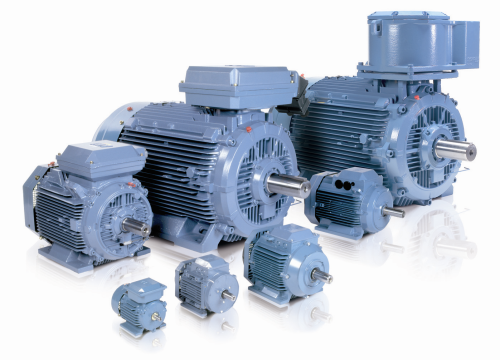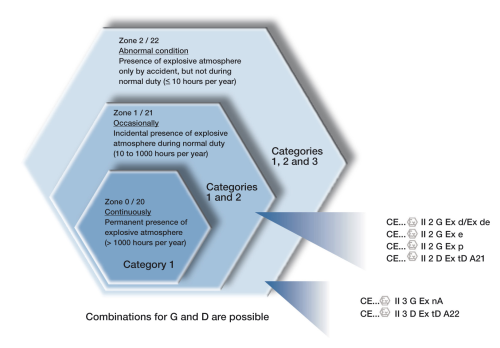

Low voltage AC drives used with electric motors can offer significant process improvements and energy savings for pumps, fans and other equipment used in hazardous areas. These benefits of using AC drives are the same as those achieved in applications in ordinary, non-hazardous areas. To ensure safety, the use of low voltage AC drives in hazardous areas is regulated by the ATEX directives. There are several ways to secure safe running of low voltage AC drives in hazardous areas.
Ignition of a hazardous atmosphere can happen easily, without warning and have disastrous consequences. Escaping liquid or vapours in combination with insufficiently protected equipment can cause a powerful explosion, resulting in injuries, damage to the plant, extended downtime and lost production. The ensuing legal claims can take years to sort out. What may have started as a small fault can turn out to have major consequences for the future of the company.
Most accidents can be prevented if safety is made a priority throughout the operation. The ATEX directives have been implemented in the European Union to promote such an approach. The same principles are increasingly being applied by users all over the world.
Until the advent of the new ATEX Directives from the EU, the installation of electrical equipment in a potentially explosive atmosphere area (sometimes known as a hazardous area) was a relatively simple procedure, requiring only the selection of equipment certified for the appropriate area. Of course, before ATEX there were other recommendations, such as IEC standards, that were used to ensure safety. But such standards did not provide certification.
The implementation of the new ATEX Directives changes the perception of the specifier and rotating machine manufacturer, who now become directly concerned. The driven equipment is now specifically covered by the requirements of the Directives, as is the compatibility of all the equipment installed on a site.
Two-pronged approach
The legislation has two legs, ATEX 95 and ATEX 137. ATEX 95, the Product Directive, aims to ensure that equipment for use in hazardous areas is safe and meets applicable standards. ATEX 137, the Worker Protection Directive, concentrates on the duties of the end-user, aiming to ensure that equipment and facilities are managed responsibly when in use. As of July 2006, organisations in the EU must follow these directives to protect employees from explosion risk in areas with an explosive atmosphere.
While the end user is responsible for the installation and safe operation of equipment, the equipment manufacturer is responsible for the equipment being safe as long as it is operated in accordance with instructions. The end user must define the zone, the gas group, the temperature class and the preferred protection class. Based on this information, the manufacturer proposes the equipment to be used.
Motors and AC drives in hazardous areas
Electric motors are chosen on the basis of protection type which, in turn, is selected on the basis of zones; for instance, flameproof motors are used for Zone 1. It is possible to run hazardous area motors with speed control, as long as the effects on the motor are recognized, mainly to prevent motor surface over-temperature. The temperature of the motor can be measured directly with thermal sensors in the windings, controlling a certified disconnection. The motor temperature can also be tested by running the motor and low voltage AC drive combination across the entire speed range with its load, to ensure that the surface temperature stays within specified limits.
Another way is to control the flow of energy to the motor, thus preventing excess temperature, although this requires some experience of testing. If using an ABB industrial drive, the energy flow can be easily controlled through the drive. The motor control platform, direct torque control (DC), helps control the power transferred and with that, the motor temperature. It is also possible to purchase an ATEX approved package with motor and low voltage AC drive.
User selects equipment for Zones
ATEX 137, the worker protection directive, defines the Zones for gas and dust, indicating which Category of equipment that is to be used in each Zone. It is the end-user’s duty to select the right equipment for the respective Zone. The notion of Zones does not exist in ATEX 95, the Product Directive. Manufacturers make equipment for the different Categories and it is the manufacturer’s responsibility to select the right Category equipment for each Zone.
Zone 0 (called Zone 20 for dust) has permanent presence of explosive atmosphere and requires equipment of Category 1. No motors can be used in this Zone. Zone 1 (Zone 21 for dust) can have incidental presence of explosive atmosphere during normal duty and requires equipment of Category 1 or 2. Zone 2 (Zone 22 for dust) can have presence of explosive atmosphere by accident, but not during normal duty. This Zone can have equipment of Category 1, 2 or 3.
Motor types in Category 2 must be one of the types Ex e (increased safety), Ex p (pressurized), Ex d (flameproof) for gas, or tD A21 (dust proof enclosure) for environments with combustible dust. Motor types in Category 3 must be at least Ex nA (non-sparking) for gas, or tD A22 (dust proof enclosure) for environments with combustible dust types.
Harmonized standards
To meet the requirements, harmonized standards exist which manufacturers and end-users have to follow. For the manufacturer, the standards outline the requirements for the different types of equipment. For the end-user, the standards relate to the installation, maintenance and repair of equipment in hazardous areas, which have to be carried out according to the instructions from the manufacturer.
Certification by a Notified Body is required for motors in Category 2. The identifying number of the certifying Notified Body appears near the CE mark on the nameplate and the certificate number is part of the complementary marking on the motor nameplate.
For Category 3 motors, the directives accept self-certification by the motor manufacturer, based on internal quality control. However, this brings few benefits as the manufacturer is still required to fulfil all the requirements of the standards and the cost for using the services of a Notified Body are relatively small in the context. For these reasons, motor manufacturer ABB uses the same certification procedure for its Category 2 equipment, with the support of the relevant Notified Bodies.
If testing is required to ensure a safe motor and low voltage AC drive combination, this only needs to be carried out once. Further installations from the same manufacturer can be added without additional testing in similar load conditions.
ATEX and the world
Although the ATEX directives are only applicable within the EU, they are based on European standards which have lead to their principles being demanded by users throughout the world. However, ATEX approval is generally not recognized outside Europe and industries with hazardous areas need to investigate which approval schemes apply locally.
The Zone system is used all over the world, except in North America, where a system of Classes and Divisions is used to denote hazardous locations. The Classes are based on the type of hazard, while the Divisions are based on the risk of explosion that the material presents. Both the EU and the US systems provide effective solutions for managing electrical equipment. Some US equipment manufacturers have started using Zones to be compliant with the ATEX directives, enabling them to sell products and equipment to EU end-users.
Outside Europe and North America, IECEx is used, which follows the same standards as ATEX. The ATEX directives promote a safe working environment with good housekeeping practices to prevent accidents, along with controls to ensure safely operating equipment. As the ATEX standards gradually take hold over the market, major industrial accidents due to explosions should, hopefully, become a thing of the past.





